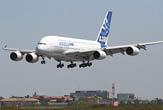Airbus A380: Inside the World's Biggest Jet

The world's biggest airliner also has the smartest cockpit, with screens that show more and make it easier to fly.
Follow along with the numbered diagram of the flight deck (click the image blow for a bigger view) to find out what's new on the Airbus A380.
The Airbus A380 was certified to fly by the FAA in March. It can carry more than 800 passengers.
1 Primary flight display is larger than older versions and shows multiple streams of information, including digital instrumentation, deftly prioritized for the pilots.
2 Navigation display registers course changes graphically when the pilot programs new waypoints. A vertical situation display shows a side profile of the flight path relative to the terrain, providing a more intuitive reading of the ground.
3 Multifunction display allows pilots to enter navigation data and radio frequencies and to communicate with flight controllers.
4 Engine warning system alerts pilots to engine and fuel-system problems.
5 Head-up display [not shown] projects data onto a retractable screen, and an optional infrared view sees through darkness and fog during takeoff and landing.
Get the world’s most fascinating discoveries delivered straight to your inbox.
6 Sidestick hand controllers move the wings and tail. Placing them on the side (instead of in the center) leaves room for a full keyboard.
7 Onboard information system displays maps and manuals and, while taxiing, runway diagrams.
How the A380 Gets More Power With Less Noise:
The four massive 70,000-pound-thrust high-bypass turbofan jet engines driving the A380 will actually be quieter than the engines on many smaller planes. That's because high-bypass engines employ carefully sculpted blades and wider fans (116 inches in the A380's Rolls Royce model) to acceleratE more air past the engine core and out the rear, allowing the engines to operate more slowly and quietly without sacrificing thrust.
For more coverage of the A380, including a time-lapse video of the mammoth jet's construction, check out this post on PopSci's blog.
- New Jet to Seek Turbulence
- Plane Crash Survival: Miracle, or Skill and Science?
- Japan to Test Supersonic Jet


